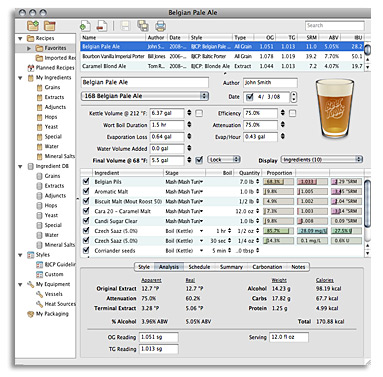 |
| The first of many homebrews, B3 2050 BrewSculpture. |
After a thorough scrub and testing of all systems (pumps, float switches, temp gauges, gas lines, digital burner, probes), it was a GO for Inaugural Pale Ale. Here's the homebrew recipe:
Inaugural Pale Ale
|
American Pale Ale
|
BJCP:
10A
|
Date: 01/14/2012
|
||||||||||||||||||||||||||||||||||||||||||||||||||||||||||||||||||||||||||||||||
Type: All Grain
|
Brewer: Sean
|
||||||||||||||||||||||||||||||||||||||||||||||||||||||||||||||||||||||||||||||||
Batch Size: 10.00 gal
|
Asst Brewer:
|
||||||||||||||||||||||||||||||||||||||||||||||||||||||||||||||||||||||||||||||||
Boil Time: 90 min
|
Equipment: B3 2050
|
||||||||||||||||||||||||||||||||||||||||||||||||||||||||||||||||||||||||||||||||
Est Original
Gravity: 1.057 SG
|
Measured Original Gravity:
1.057 SG
|
||||||||||||||||||||||||||||||||||||||||||||||||||||||||||||||||||||||||||||||||
Est Final Gravity:
1.012 SG
|
Measured Final Gravity:
1.007 SG
|
||||||||||||||||||||||||||||||||||||||||||||||||||||||||||||||||||||||||||||||||
Estimated Alcohol by Vol:
6.0 %
|
Actual Alcohol by Vol: 6.6 %
|
||||||||||||||||||||||||||||||||||||||||||||||||||||||||||||||||||||||||||||||||
IBUs (Tinseth’s):
42.9 IBUs
|
Est Color:
5.9 SRM
|
||||||||||||||||||||||||||||||||||||||||||||||||||||||||||||||||||||||||||||||||
Total Hop Weight: 8.00 oz
|
Calories: 187.8 kcal/12oz
|
||||||||||||||||||||||||||||||||||||||||||||||||||||||||||||||||||||||||||||||||
Description:
|
|||||||||||||||||||||||||||||||||||||||||||||||||||||||||||||||||||||||||||||||||
|
|||||||||||||||||||||||||||||||||||||||||||||||||||||||||||||||||||||||||||||||||
|
|||||||||||||||||||||||||||||||||||||||||||||||||||||||||||||||||||||||||||||||||
Mash Type: Single Infusion, Light Body, No Mash Out
|
Total Grain Weight:
21 lbs
|
||||||||||||||||||||||||||||||||||||||||||||||||||||||||||||||||||||||||||||||||
Sparge Temperature:
168.0 F
|
Pre-boil Volume:
11.15 gal
|
||||||||||||||||||||||||||||||||||||||||||||||||||||||||||||||||||||||||||||||||
Days in Primary: 4.00
|
Primary Temperature:
66.0 F
|
||||||||||||||||||||||||||||||||||||||||||||||||||||||||||||||||||||||||||||||||
Days in Secondary:
10.00
|
Secondary Temperature:
60.0 F
|
||||||||||||||||||||||||||||||||||||||||||||||||||||||||||||||||||||||||||||||||
Days in Tertiary: 7.00
|
Tertiary Temperature:
65.0 F
|
||||||||||||||||||||||||||||||||||||||||||||||||||||||||||||||||||||||||||||||||
Carbonation Type:
Keg
|
Volumes of CO2: 2.3
|
||||||||||||||||||||||||||||||||||||||||||||||||||||||||||||||||||||||||||||||||
Pressure/Weight:
12.54 PSI
|
Carbonation Used:
Keg with 12.54 PSI
|
||||||||||||||||||||||||||||||||||||||||||||||||||||||||||||||||||||||||||||||||
Keg/Bottling Temperature:
45.0 F
|
Storage Temperature:
45.0 F
|
||||||||||||||||||||||||||||||||||||||||||||||||||||||||||||||||||||||||||||||||
Notes: Pale Ale, such an under appreciated style these days. Especially in San Diego, where I like to tell people that IPA flows out of drinking fountains, pale ale just sounds ordinary. As one of my favorite beers styles, I haven't brewed a pale ale in such a long time. I wanted to brew a great first beer on the new MoreBeer B2050 BrewSculpture and pale ale was very appropriate.
Suprisingly, the brew day went very smooth. Over a decade of homebrewing enabled a fairly easy transition. Hops at 0 minutes were used in a Hop Rocket. Nugget and part of the Cascade hops were homegrown by Travis. Centennial from my farm. |
|||||||||||||||||||||||||||||||||||||||||||||||||||||||||||||||||||||||||||||||||
Created with BeerSmith
|
|||||||||||||||||||||||||||||||||||||||||||||||||||||||||||||||||||||||||||||||||
There were a few minor hiccups during the first brew but nothing that hindered the bulk of the process. I was having way too much fun to really care about the details. The second batch had to wait a few weeks but by then all the kinks were worked out.
 |
| Getting ready to heat up the mash liquor. |
Start Your Steam Engines
|
California Common Beer
|
BJCP:
7B
|
Date: 02/02/2012
|
||||||||||||||||||||||||||||||||||||||||||||||||||||||||||||||||||||||||||||||||
Type: All Grain
|
Brewer: Sean
|
||||||||||||||||||||||||||||||||||||||||||||||||||||||||||||||||||||||||||||||||
Batch Size: 10.00 gal
|
Asst Brewer:
|
||||||||||||||||||||||||||||||||||||||||||||||||||||||||||||||||||||||||||||||||
Boil Time: 90 min
|
Equipment: B3 2050
|
||||||||||||||||||||||||||||||||||||||||||||||||||||||||||||||||||||||||||||||||
Est Original
Gravity: 1.066 SG
|
Measured Original Gravity:
1.065 SG
|
||||||||||||||||||||||||||||||||||||||||||||||||||||||||||||||||||||||||||||||||
Est Final Gravity:
1.021 SG
|
Measured Final Gravity:
1.014 SG
|
||||||||||||||||||||||||||||||||||||||||||||||||||||||||||||||||||||||||||||||||
Estimated Alcohol by Vol:
6.0 %
|
Actual Alcohol by Vol: 6.7 %
|
||||||||||||||||||||||||||||||||||||||||||||||||||||||||||||||||||||||||||||||||
IBUs (Tinseth’s):
32.6 IBUs
|
Est Color:
12.0 SRM
|
||||||||||||||||||||||||||||||||||||||||||||||||||||||||||||||||||||||||||||||||
Total Hop Weight: 6.00 oz
|
Calories: 219.2 kcal/12oz
|
||||||||||||||||||||||||||||||||||||||||||||||||||||||||||||||||||||||||||||||||
Description:
|
|||||||||||||||||||||||||||||||||||||||||||||||||||||||||||||||||||||||||||||||||
|
|||||||||||||||||||||||||||||||||||||||||||||||||||||||||||||||||||||||||||||||||
|
|||||||||||||||||||||||||||||||||||||||||||||||||||||||||||||||||||||||||||||||||
Mash Type: SMART 154 and Mash Out
|
Total Grain Weight:
25 lbs 2.1 oz
|
||||||||||||||||||||||||||||||||||||||||||||||||||||||||||||||||||||||||||||||||
Sparge Temperature:
168.0 F
|
Pre-boil Volume:
12.56 gal
|
||||||||||||||||||||||||||||||||||||||||||||||||||||||||||||||||||||||||||||||||
Days in Primary: 14.00
|
Primary Temperature:
60.0 F
|
||||||||||||||||||||||||||||||||||||||||||||||||||||||||||||||||||||||||||||||||
Days in Secondary:
10.00
|
Secondary Temperature:
65.0 F
|
||||||||||||||||||||||||||||||||||||||||||||||||||||||||||||||||||||||||||||||||
Days in Tertiary: 7.00
|
Tertiary Temperature:
65.0 F
|
||||||||||||||||||||||||||||||||||||||||||||||||||||||||||||||||||||||||||||||||
Carbonation Type:
Keg
|
Volumes of CO2: 2.5
|
||||||||||||||||||||||||||||||||||||||||||||||||||||||||||||||||||||||||||||||||
Pressure/Weight:
12.27 PSI
|
Carbonation Used:
Keg with 12.27 PSI
|
||||||||||||||||||||||||||||||||||||||||||||||||||||||||||||||||||||||||||||||||
Keg/Bottling Temperature:
40.0 F
|
Storage Temperature:
40.0 F
|
||||||||||||||||||||||||||||||||||||||||||||||||||||||||||||||||||||||||||||||||
Notes: This time of year, from a combination of old plaster walls and wood floors, the house fermentation area maintains a consistent 58-60°F. Too cold for ales and too warm for lagers but close enough for a hybrid yeast strain such as White Labs WLP810 San Francisco Lager to thrive. Recipe formulation started with Jamil's recipe shared during his Brewing Network podcast on brewing California Common.
|
|||||||||||||||||||||||||||||||||||||||||||||||||||||||||||||||||||||||||||||||||
Created with BeerSmith
|
|||||||||||||||||||||||||||||||||||||||||||||||||||||||||||||||||||||||||||||||||





































